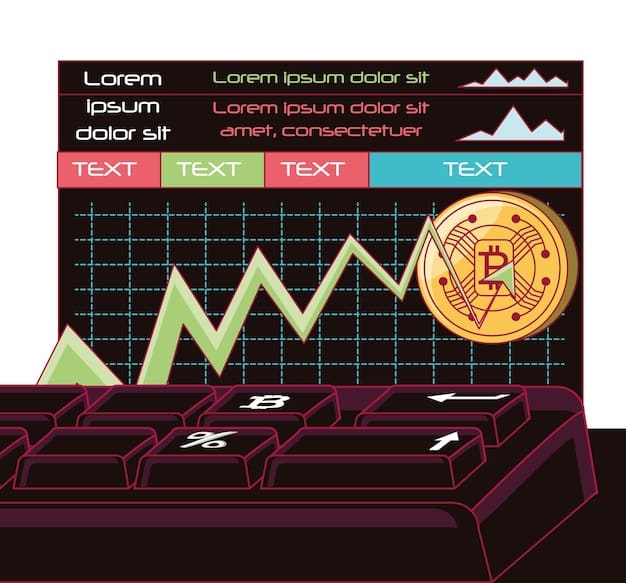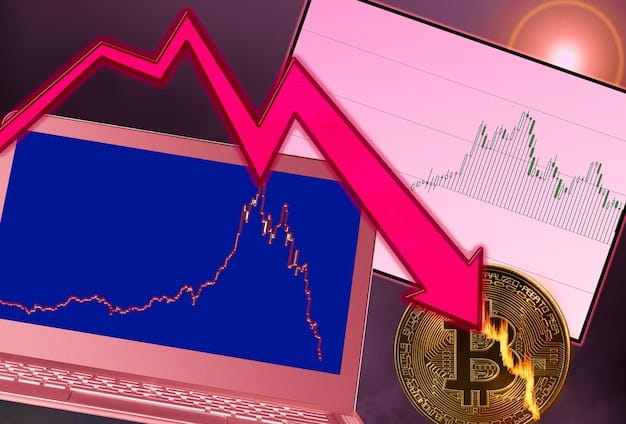Bitcoin Halving 2024: Impact on US Market & Price Analysis

The Bitcoin halving in 2024, which occurred on April 19th, reduced the block reward from 6.25 BTC to 3.125 BTC, impacting miners’ revenue, potentially decreasing the new supply rate, and affecting Bitcoin’s price dynamics in the US market due to expectations of scarcity and increased demand.
Did the Bitcoin Halving 2024: How Did It Affect Bitcoin’s Price in the US Market? Discover the immediate and long-term consequences on supply, demand, and investor sentiment in America.
Understanding the Basics of Bitcoin Halving
Bitcoin halving is a pre-programmed event that occurs approximately every four years, or after every 210,000 blocks are mined. This event reduces the reward given to miners for verifying transactions and adding new blocks to the blockchain by 50%. Bitcoin’s code ensures that only 21 million Bitcoins will ever be produced, and the halving is a mechanism to control the supply rate.
The primary purpose of halving is to maintain scarcity and control inflation within the Bitcoin network. By cutting the reward in half, the rate at which new Bitcoins enter the market is reduced, aligning with the principles of deflationary economics. This mechanism is crucial to Bitcoin’s value proposition as a digital asset with a limited supply.

Historical Halving Events
To better understand the potential impact of the 2024 halving, it’s essential to review previous occurrences. Here’s a brief overview:
- First Halving (2012): The reward was reduced from 50 BTC to 25 BTC. In the following year, Bitcoin’s price saw a significant increase.
- Second Halving (2016): The reward was reduced from 25 BTC to 12.5 BTC. Again, the price experienced notable growth over the next 12-18 months.
- Third Halving (2020): The reward was reduced from 12.5 BTC to 6.25 BTC. A substantial bull run followed, with Bitcoin reaching new all-time highs.
Each halving event has historically been followed by an increase in Bitcoin’s price, though the exact timing and magnitude of these increases have varied. These past events provide valuable, although not definitive, insights into how the market may react to the 2024 halving.
The 2024 Halving Event: A Closer Look
The Bitcoin halving in 2024 occurred on April 19th, marking another significant milestone in the cryptocurrency’s lifecycle. This event saw the block reward reduced from 6.25 BTC to 3.125 BTC, directly impacting miners’ revenue and the overall supply of new Bitcoin entering the market.
This halving has been highly anticipated by investors, analysts, and enthusiasts alike. The reduced block reward has several immediate and potential longer-term effects on the Bitcoin ecosystem, especially concerning price dynamics.
Impact on Bitcoin Miners
One of the most direct consequences of the halving is the reduced revenue for Bitcoin miners. With the block reward cut in half, miners now receive fewer Bitcoins for their computational efforts in verifying transactions. This reduction can lead to several outcomes:
- Miner Consolidation: Less efficient miners might struggle to remain profitable, potentially leading to a consolidation of mining operations among larger, more efficient entities.
- Increased Transaction Fees: To compensate for the lower block reward, miners may prioritize transactions with higher fees, potentially increasing transaction costs for users.
- Shift to Alternative Cryptocurrencies: Some miners may explore mining other cryptocurrencies to maintain their revenue streams.
Even with these challenges, the halving can also incentivize miners to become more efficient and technologically advanced, fostering innovation within the mining sector.
How Did the 2024 Halving Affect Bitcoin’s Price in the US?
The immediate reaction of Bitcoin’s price to the 2024 halving has been a subject of much debate and observation. Predicting the precise timing and magnitude of price movements is challenging, but several factors come into play when assessing the halving’s impact.
Historically, halvings have been followed by significant price increases, driven by the reduced supply and increased demand. However, the market’s response to the 2024 halving is influenced by numerous other economic and market factors.

Short-Term Price Fluctuations
In the immediate aftermath of the halving, Bitcoin’s price may experience volatility. This volatility can be attributed to:
- Speculative Trading: Traders often engage in speculative buying and selling, leading to short-term price swings.
- Market Sentiment: News and commentary surrounding the halving can influence investor sentiment, affecting buying and selling pressure.
- Profit-Taking: Some investors may choose to take profits after the halving, contributing to temporary price dips.
It’s essential to consider these factors when evaluating the initial price movements following the halving. Short-term volatility doesn’t necessarily indicate the long-term trend.
Long-Term Price Predictions and Analysis
Over the longer term, the halving’s impact on Bitcoin’s price is typically more pronounced. Reduced supply coupled with sustained or increased demand often leads to price appreciation. Several factors support this long-term bullish outlook:
Scarcity plays a crucial role, as the halving reduces the number of new Bitcoins entering the market. If demand remains constant or rises, this decreased supply can drive prices upward.
Fundamental Factors Driving Demand
Demand for Bitcoin in the US market is influenced by several factors:
- Institutional Adoption: Increasing interest and investment from institutional investors can boost Bitcoin’s legitimacy and drive demand.
- Macroeconomic Conditions: Economic factors such as inflation and interest rates can impact Bitcoin’s appeal as a store of value.
- Regulatory Developments: Clear and favorable regulatory frameworks can foster greater adoption and investment in Bitcoin.
Analyzing these factors helps provide a more comprehensive view of Bitcoin’s potential long-term price trajectory.
The US Market’s Unique Position
The United States plays a unique role in the Bitcoin market due to its large economy, advanced financial infrastructure, and significant investor base. The US market’s dynamics can amplify or dampen the effects of the halving.
Regulatory clarity, or the lack thereof, in the US can significantly impact investor confidence and market activity. Favorable regulations can attract more institutional and retail investors, while uncertainty can deter them.
Regulatory Landscape in the US
Key considerations regarding regulation include:
- SEC’s Stance: The Securities and Exchange Commission’s (SEC) approach to cryptocurrencies can influence market sentiment and investment flows.
- Tax Policies: Clear and fair tax policies can promote greater adoption and reduce uncertainty for investors.
- State-Level Regulations: Different states may have varying regulations, creating a patchwork of rules that can impact Bitcoin businesses and investors.
Staying informed about regulatory developments is crucial for understanding the US market’s response to the halving.
Strategies for Investors and Traders
Given the complexity and potential volatility surrounding the halving, both investors and traders should adopt strategies to manage risks and capitalize on opportunities.
Diversification is a fundamental principle. Investors should avoid putting all their eggs in one basket and consider spreading their investments across various asset classes to mitigate risks.
Risk Management Techniques
Effective risk management includes:
- Setting Stop-Loss Orders: These orders automatically sell an asset if it reaches a certain price, limiting potential losses.
- Using Leverage Carefully: While leverage can amplify gains, it can also magnify losses, making it essential to use it judiciously.
- Staying Informed: Keeping up-to-date with market news, trends, and analysis can help investors make informed decisions.
By employing these strategies, investors can better navigate the complexities of the Bitcoin market and mitigate potential risks associated with the halving.
| Key Point | Brief Description |
|---|---|
| 💰 Halving Impact | Reduces miner rewards, affecting supply and potentially increasing price. |
| ⛏️ Miner Strategies | Miners adapt to reduced rewards through efficiency and higher fees. |
| 📈 US Market Response | US market influenced by regulations, institutional adoption, and economic conditions. |
| 🛡️ Risk Management | Investors can manage risk through diversification and stop-loss orders. |
Frequently Asked Questions
▼
Bitcoin halving is an event that reduces the reward for mining new blocks by 50%, occurring roughly every four years. This mechanism controls the supply of new bitcoins entering the market.
▼
Halving reduces the block reward miners receive, potentially leading to miner consolidation, increased transaction fees, or a shift to alternative cryptocurrencies.
▼
Historically, halvings have been followed by notable price increases due to reduced supply and sustained or growing demand, but short-term volatility is also common.
▼
Institutional adoption levels, macroeconomic conditions like inflation, and developments in regulatory frameworks significantly impact Bitcoin’s US market performance.
▼
Diversification, setting stop-loss orders, and careful leverage usage are important risk management tactics for mitigating potential risks after a halving.
Conclusion
The Bitcoin Halving 2024: How Did It Affect Bitcoin’s Price in the US Market? While short-term market reactions can be uncertain, historical trends show that halvings often contribute to price appreciation over the long term. By staying informed, managing risks, and understanding the unique dynamics of the US market, investors can navigate the opportunities and challenges that the halving presents.





